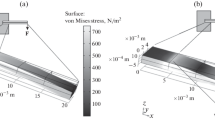Abstract
An experimental method is developed to perform Hopkinson tests by means of viscoelastic bars by considering the wave propagation attenuation and dispersion due to the material rheological properties and the bar radial inertia (geometric effect). A propagation coefficient, representative of the wave dispersion and attenuation, is evaluated experimentally. Thus, the Pochhammer and Chree frequency equation is not necessary. Any bar cross-section shapes can be employed, and the knowledge of the bar mechanical properties is useless. The propagation coefficients for two PMMA bars with different diameters and for an elastic aluminum alloy bar are evaluated. These coefficients are used to determine the normal forces at the free end of a bar and at the ends of two bars held in contact. As an application, the mechanical impedance of an accelerometer is evaluated.
Similar content being viewed by others
Abbreviations
- a :
-
bar radius
- A :
-
cross-sectional area of the bar
- c(ω):
-
phase velocity
- c 0 :
-
one-dimensional elastic wave speed
- d :
-
distance between the strain gage location and the nonimpacted end
- E :
-
Young's modulus
- E *(ω):
-
complex Young's modulus
- \(\tilde f(x,\omega )\) :
-
Fourier transform of functionf(x, t) at cross sectionx
- F :
-
normal force
- H *(ω):
-
strain transfer function
- k(w):
-
wave number
- L :
-
bar length
- m :
-
accelerometer mass
- \(\tilde N(\omega )\) :
-
Fourier transform of the strain atx=0 due to the wave traveling in the direction of decreasingx
- \(\tilde P(\omega )\) :
-
Fourier transform of the strain atx=0 due to the wave traveling in the direction of increasingx
- t :
-
time
- u :
-
axial displacement
- v :
-
axial particle velocity
- Z *(ω):
-
mechanical impedance
- α(ω):
-
attenuation coefficient
- ε:
-
longitudinal strain
- εI(t):
-
longitudinal strain due to the incident wave
- ε R (t):
-
longitudinal strain due to the reflected wave
- γ(ω):
-
propagation coefficient
- ν:
-
frequency
- ω:
-
angular frequency
- ρ:
-
mass density of the bar
- σ:
-
normal stress
References
Kolsky, H., Stress Waves in Solids, Dover, New York (1963).
Lundberg, B. andHenchoz, A., “Analysis of Elastic Waves from Two-point Strain Measurement,” EXPERIMENTAL MECHANICS,17,213–218 (1977).
Bacon, C. “Mesure de la ténacité dynamique de matériaux fragiles en flexion-trois-points à haute température—Utilisation des barres de Hopkinson,” Ph.D. thesis, Université Bordeaux, 1, No. 840 (1993).
Lundberg, B., Carlsson, J., andSundin, K.G., “Analysis of Elastic Waves in Non-uniform Rods from Two-point Strain Measurement,”J. Sound Vibration,137,483–493 (1990).
Bacon, C., Carlsson, J., andLataillade, J.L., “Evaluation of Force and Particle Velocity at the Heated End of a Rod Subjected to Impact Loading,”J. Physique IV, Colloque C3,1,395–401 (1991).
Bacon, C., Färm, J., andLataillade, J.L., “Dynamic Fracture Toughness Determined from Load-point Displacement,” EXPERIMENTAL MECHANICS,34,217–223 (1994).
Follansbee, P.S. andFrantz, C., “Wave Propagation in the Split Hopkinson Pressure Bar,”J. Eng. Mat. Tech.,105,61–66 (1983).
Gorham, D.A. andWu, X.J., “An Empirical Method for Correcting Dispersion in Pressure Bar Measurements of Impact Stress,”Meas. Sci. Tech. 7,1227–1323 (1996).
Wang, L., Labibes, K., Azari, Z., andPluvinage, G., “Generalization of Split Hopkinson Bar Technique to Use Viscoelastic Bars,”Int. J. Impact Eng.,15,669–686 (1994).
Zhao, H. andGary, G., “A Three Dimensional Analytical Solution of the Longitudinal Wave Propagation in an Infinite Linear Viscoelastic Cylindrical Bar. Application to Experimental Techniques,”J. Mech. Phys. Solids,43,1335–1348 (1995).
Zhao, H., Gary, G., andKlepaczko, J. R., “On the Use of a Viscoelastic Split Hopkinson Pressure Bar,”Int. J. Impact Eng.,19,319–330 (1997).
Zhao, H. andGary, G., “A New Method for the Separation of Waves. Application to the SHPB Technique for an Unlimited Duration of Measurement,”J. Mech. Phys. Solids,45,1185–1202 (1997).
Achenbach, J.D., Wave Propagation in Elastic Solids, North-Holland (1973).
Lundberg, B. andBlanc, R. H., “Determination of Mechanical Material Properties from the Two-point Response of an Impacted Linearly Viscoelastic Rod Specimen,”J. Sound Vibration,126,97–108 (1988).
Author information
Authors and Affiliations
Additional information
A part of this work has been performed in the Laboratoire Matériaux Endommagement Fiabilité of the Ecole Nationale Supérieure des Arts et Métiers de Bordeaux.
Rights and permissions
About this article
Cite this article
Bacon, C. An experimental method for considering dispersion and attenuation in a viscoelastic Hopkinson bar. Experimental Mechanics 38, 242–249 (1998). https://doi.org/10.1007/BF02410385
Received:
Revised:
Issue Date:
DOI: https://doi.org/10.1007/BF02410385




